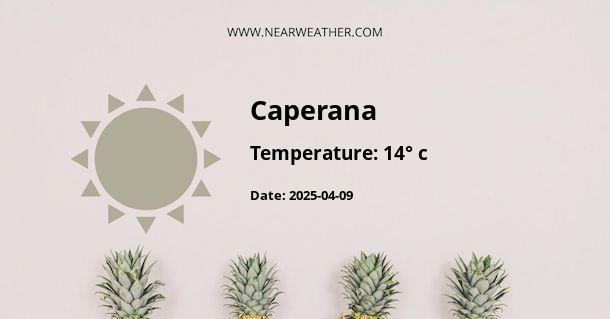Climate and Weather Patterns of Capraia, Italy
Capraia is an Italian island, the northwesternmost of the seven islands of the Tuscan Archipelago, and a captivating location with a unique climate influenced by its maritime position in the Mediterranean Sea. Understanding the climate and weather patterns of Capraia can offer valuable insights for travelers, researchers, and residents alike. This detailed exploration of Capraia's climate will delve into the seasonal variations, historical weather data, and climatic influences shaping the island's weather year-round.
Geographical Influence on Capraia's Climate
Located in the Tyrrhenian Sea, Capraia is the third-largest island of the Tuscan Archipelago National Park. The topography, which includes mountainous terrains and a rugged coastline, plays a crucial role in the local climate. The island's highest peak, Monte Castello, approximately 447 meters above sea level, can cause microclimatic variations.
Mediterranean Climate Characteristics
Capraia exhibits a typical Mediterranean climate (Köppen climate classification: Csa), which entails:
- Mild, wet winters
- Warm, dry summers
- Transitional mild and moderately wet autumns and springs
"The Mediterranean climate is characterized by dry summers and rainy winters, but the severity of those seasons can vary considerably from one place to another due to the region's topography and latitude." - National Oceanic and Atmospheric Administration (NOAA)
Seasonal Weather Patterns
Spring
Spring in Capraia begins gently with an increase in temperature and a decrease in rainfall.
| Month | Average High (°C) | Average Low (°C) | Average Rainfall (mm) |
|---|---|---|---|
| March | 13 | 8 | 80 |
| April | 16 | 11 | 75 |
| May | 20 | 14 | 50 |
These averages show a clear warming trend as Capraia heads into summer.
Summer
Summertime brings the quintessential Mediterranean climate that the island is known for:
| Month | Average High (°C) | Average Low (°C) | Average Rainfall (mm) |
|---|---|---|---|
| June | 24 | 18 | 30 |
| July | 27 | 21 | 10 |
| August | 27 | 21 | 20 |
The long, sunlit days are perfect for enjoying the island's pristine beaches and outdoor activities.
Autumn
The transition to cooler weather brings a noticeable change:
| Month | Average High (°C) | Average Low (°C) | Average Rainfall (mm) |
|---|---|---|---|
| September | 23 | 19 | 70 |
| October | 19 | 15 | 95 |
| November | 15 | 11 | 110 |
This period can be characterized by mild temperatures and a gradual increase in precipitation.
Winter
Colder months bring the most rainfall of the year, although temperatures remain moderate compared to continental Europe.
| Month | Average High (°C) | Average Low (°C) | Average Rainfall (mm) |
|---|---|---|---|
| December | 12 | 8 | 100 |
| January | 11 | 7 | 80 |
| February | 11 | 7 | 75 |
These conditions are relatively pleasant, with rare occurrences of frost or snow due to the insulating effect of the sea.
Wind Patterns
Winds influence Capraia's climate significantly. The most notable are:
- Mistral (Maestrale): This northwest wind can lower temperatures, increase waves and is most common during winter and spring.
- Sirocco (Scirocco): Coming from the southeast, this hot, humid wind originates in the Sahara Desert and can affect Capraia, especially in autumn.
- Libeccio: A southwest wind bringing moist, unstable conditions, often precedes storm weather.
Climate Change Impacts
Research into the Mediterranean region has shown that climate change is impacting weather patterns, with potential effects including:
- Increase in average temperatures and heat waves
- Altered precipitation patterns, risking longer drought periods
- Sea-level rise, affecting coastal ecosystems and human activities
"The Mediterranean region is warming 20% faster than the global average, according to a report published by the Mediterranean Experts on Climate and Environmental Change (MedECC), making it more prone to severe weather conditions and climate extremes."
Marine Climate and Sea Temperature
Considering Capraia's island status, sea temperatures also merit attention. They follow a seasonal trend, influencing coastal weather and providing a comfortable environment for marine activities during the warmer months. Typical sea temperatures range from about 14°C in winter to 24°C in late summer.
Climate Data Considerations
When planning to visit or study Capraia's climate, always refer to the latest meteorological data and forecasts. Sources such as the Italian Meteorological Service (Servizio Meteorologico) provide valuable, up-to-date information. Historic trends are critical, but the unpredictability of weather patterns, especially in the context of climate change, necessitates real-time data for accurate decision-making.
Furthermore, engaging with climate models and research from authoritative bodies like the Intergovernmental Panel on Climate Change (IPCC) can provide deeper insights into long-term trends and help in understanding how the island's climate might evolve in the coming years.
Conclusion
Capraia Island presents a fascinating and complex weather system. Its Mediterranean climate provides distinct seasonal changes that influence not just the environment but also the lifestyle of its inhabitants and visitors. With considerations for ongoing climate change and its implications, those interested in Capraia's weather patterns should stay informed through reliable, science-based resources. Whether for travel, study, or simple curiosity, understanding the climate of Capraia ensures a deeper appreciation for this unique and enchanting island.
A - Caperana's Latitude is 44.330559 & Longitude is 9.345830.
A - Weather in Caperana is 14° today.
A - Climate Conditions in Caperana shows overcast clouds today.
A - Humidity in Caperana is 84% today.
A - Wind speed in Caperana is 4.82 km/h, flowing at 98° wind direction. today.
